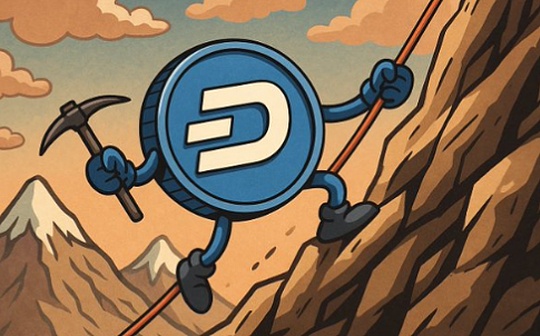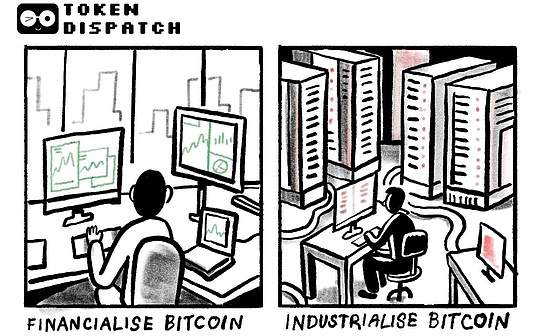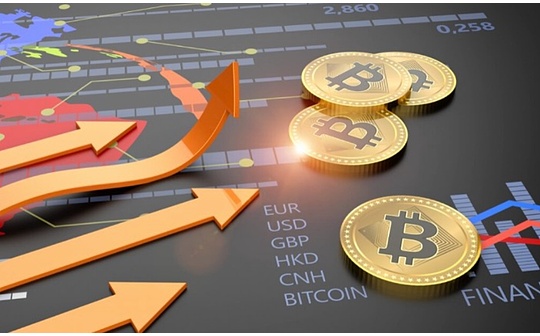
Author: Lyn Alden, compiled by: AididiaoJP
Although crypto-punk and traditional institutions have different views on Bitcoin stocks, they all make sense.Bitcoin must function as a free currency, but it is also perfectly reasonable to have a large amount of capital pouring into Bitcoin.
Over the past year or so, the rise in Bitcoin has been largely driven by the rise of the Bitcoin treasury strategy of listed companies.
Although micro-strategy set this precedent as early as 2020, other companies have followed up slowly.However, after the 2023 Financial Accounting Standards Board (FASB) made a major update on how Bitcoin’s accounting treatments are conducted on the balance sheet, a new wave of Bitcoin’s treasury asset strategy was ushered in 2024 and 2025.
This article discusses this trend and analyzes its impact on the overall Bitcoin ecosystem.The article also explores related topics of Bitcoin as a medium of exchange and a means of store of value.
Why Bitcoin stocks and bonds?
Back in August 2024, when the trend was still in its infancy, I wrote an article titled “A New Look at Corporate Treasury Strategy” explaining the practicality of Bitcoin as a corporate treasury asset.Only a few companies adopted this strategy on a large scale at that time, and since then, more and more new and existing companies have begun to adopt this strategy.And those companies that adopted this strategy on a large scale in the early stages, such as MicroStrategy and Metaplanet, had sharply increased their share prices and market capitalization.
The article explains why companies should consider implementing this strategy.But what about investors?Why is this strategy so attractive to them?From an investor’s perspective, why buy Bitcoin stocks instead of buying Bitcoin directly?There are several main reasons.
Bitcoin Stocks, Reason 1: Restricted Capital
There are trillions of custodial capital around the world, and some of them have strict investment restrictions.
For example, some stock funds can only be used to purchase stocks and cannot purchase bonds, ETFs, commodities or other assets.Similarly, some bond funds can only buy bonds.Of course, there are more specific restrictions, such as fund managers can only purchase health care stocks or non-investment-grade bonds.
Some of these fund managers are optimistic about Bitcoin, and many even hold Bitcoin themselves.But they cannot directly obtain Bitcoin exposure through the fund.However, if someone issues a stock with Bitcoin on the balance sheet (Bitcoin stock) or issues convertible bonds for a company with Bitcoin on the balance sheet, they can avoid restrictions to make purchases.This is a market that has not been developed before and is now gradually being discovered in the United States, Japan, the United Kingdom, South Korea and other places.
I have been doing real-life funding model portfolios since 2018 so readers can track my positions.
At the beginning of 2020, I strongly recommended Bitcoin as an investment target and invested myself.I wanted to include some bitcoin exposure in my model portfolio, but the brokerage account I used for the portfolio at the time was unable to buy bitcoin or bitcoin-related securities.I can’t even buy Grayscale Bitcoin Trust (GBTC) because it’s on OTC and not listed on major exchanges.
Fortunately, MicroStrategies included Bitcoin on its balance sheet in August 2020.The stock is listed on NASDAQ and my model portfolio brokerage account can be purchased directly.So considering the various limitations of the combination, I am very happy to be able to buy MSTR early on, a decision that has paid off in the past five years:
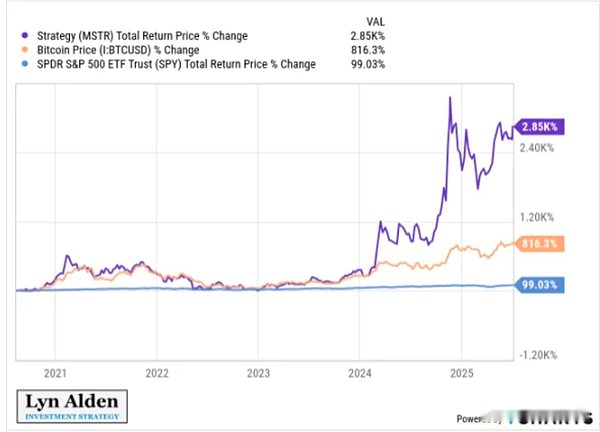 Later, the brokerage account added purchaseable securities GBTC, and of course the major spot Bitcoin ETFs were added.Nevertheless, I still hold MSTR in the combo.
Later, the brokerage account added purchaseable securities GBTC, and of course the major spot Bitcoin ETFs were added.Nevertheless, I still hold MSTR in the combo.
In short, due to investment restrictions, many funds can only hold stocks or bonds with Bitcoin exposure, and cannot hold ETFs or similar securities.Bitcoin Treasury Corporation (“Bitcoin Stocks”) provides them with opportunities.
This does not conflict with Bitcoin as a bearer asset that individuals can self-custodial, but complements each other.
Bitcoin Stocks, Reason 2: Businesses have ideal leverage
The basic strategy for enterprises to adopt Bitcoin as a treasury asset is to hold Bitcoin rather than cash equivalents.However, the first batch of Bitcoin stocks often have high confidence in this concept.So they are not just buying Bitcoin directly, but buying Bitcoin through leverage.
And listed companies happen to have better leverage tools than hedge funds and most other capital, specifically they have the ability to issue corporate bonds.
Hedge funds and certain other capitals usually use margin loans.They borrow money to buy more assets, but if the asset value drops too much relative to the amount of the borrowing, they will face a margin call.Margins could force hedge funds to sell assets when prices drop sharply, even if they firmly believe that these assets will recover and hit new highs, and being forced to sell quality assets at lows is a disaster.
In contrast, companies can issue bonds, usually with a maturity of several years.If they hold Bitcoin and the price falls, they don’t need to be forced to sell due to the decline in Bitcoin.This makes them more resistant to volatility than entities that rely on margin loans.Of course there are still bearish scenarios that may force firms to liquidate, but these scenarios will take longer to happen, so the likelihood is lower.
This long-term corporate leverage is usually better than leveraged ETFs.Since leveraged ETFs cannot use long-term debt and leverage resets daily, volatility often has adverse effects.
What happens to a 2x leverage ETF if the underlying asset fluctuates alternately with +10% and -10% on the trading day?Over time, the index of leveraged products relative to their tracking will gradually deteriorate.
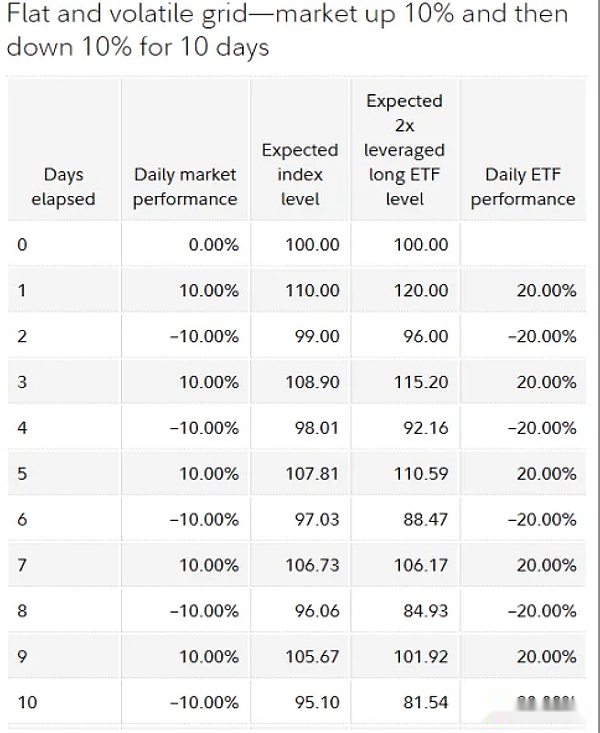
In fact, the 2x leveraged Bitcoin ETF BITU has not really outperformed Bitcoin since its inception, although Bitcoin’s price has risen during this period.You might expect the 2x leverage version to be a big outperform, but in reality it mainly adds volatility without bringing higher returns.Here is a chart of how BITU has performed since its inception:
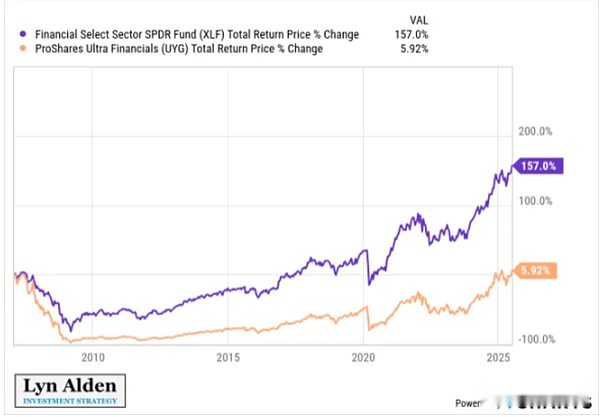 The same situation has also occurred in the long-term history of stocks with high volatility, such as the 2-fold leverage ETFs in the financial sector or the energy sector.During fluctuations, they lag far behind:
The same situation has also occurred in the long-term history of stocks with high volatility, such as the 2-fold leverage ETFs in the financial sector or the energy sector.During fluctuations, they lag far behind:
 Therefore, unless you are a short-term trader, choosing intraday leverage is usually poor.Volatility is very unfavorable to leverage.
Therefore, unless you are a short-term trader, choosing intraday leverage is usually poor.Volatility is very unfavorable to leverage.
However, the same problem does not usually occur with long-term debt to assets.Appreciation assets with multi-year debt are an attractive combination.Therefore, Bitcoin Treasury companies are attractive securities for high-conviction Bitcoin bulls, and they hope to improve returns through reasonable and secure leverage.
Not everyone should use leverage, but those who choose to use leverage will naturally want to do it in an optimized way.Nowadays, Bitcoin Treasury companies with various risk characteristics, scales, industries and jurisdictions, real market demand is gradually being met.
Some of the securities issued by these companies, such as convertible bonds or preferred stocks, can provide Bitcoin price exposure while reducing volatility.Diversified securities provide investors with the specific types of exposure they need.
What is the impact of Bitcoin Treasury on Bitcoin?
Now that we know the reasons why Bitcoin Treasury companies exist and the market gaps they fill for investors, the next question is: Are they beneficial to the Bitcoin network as a whole?Will their existence harm the value of Bitcoin as a free currency?
First of all, it is necessary to clarify what the theoretical development path of a decentralized currency is if it succeeds.What steps do you need to go through and what is the general order?
Therefore, this section will be divided into two parts.The first part is an economic analysis of how a new form of currency is popular, i.e., what the path to success might look like.The second part is to analyze whether the company promotes or hinders this path.
Part 1: What will success look like?
“What would it look like if a global, digital, sound, open source, programmable currency was circulated from scratch?”
Ludwig Wittgenstein once asked a friend, “Tell me why people think that the sun is more natural than the earth’s rotation?” The friend replied, “Well, obviously, it seems that the sun is revolving around the earth.” Ludwig asked, “So, if the earth seemed to be rotating, what would it look like?”
——”Wittgenstein’s Currency”, Allen Farrington, 2020
Bitcoin was born in early 2009, and during 2009 and 2010, some enthusiasts mined, collected, tested, bought and sold Bitcoin, or studied whether it could contribute or improve it in some way.They are addicted to the idea of Bitcoin.
In 2010, Satoshi Nakamoto himself described on the Bitcoin forum how to give initial value to Bitcoin from scratch:
“As a thought experiment, suppose there is a precious metal that is as scarce as gold, but has the following characteristics:
-
Monotonous and dark colors
-
Poor conductivity
-
Not high strength, ductility or forging is not good
-
No practical or decorative purpose
And a special, magical property:
-
Can be transmitted through communication channels
If it gains any value for some reason, anyone who wants to transfer wealth from a distance can buy some for transmission and the recipient can sell.”
After initial success, Bitcoin faced a challenge that payment networks have spawned countless competitors.Countless altcoins emerge, which have similar functions, mainly to be purchased, transmitted, and sold by the recipient.The stablecoin launched in 2014 eliminated token volatility through US dollar collateral.
The rise of competitors is actually the biggest reason why I didn’t buy Bitcoin in early 2010.It’s not that I object to this concept, but I think the industry is full of speculative bubbles and can be replicated infinitely.In other words, the supply of Bitcoin may be limited, but its philosophy is unlimited.
But in the second half of 2010, I noticed one thing: Bitcoin’s network effects are constantly evolving.Just like communication protocols, Bitcoin benefits greatly from network effects.The more people used, the more useful it will be for others, which is a cycle of self-reinforcement.And this is exactly what it means to hold Bitcoin.The network effect must continue to grow to surpass this niche and crowded stage.
We can divide currencies into two categories:
The first category is “situational currency”, which refers to currencies that can solve specific problems but are not widely used in other aspects.An asset that can be purchased in local currency, transmitted through high slippage (capital control, payment platform ban, etc.), and sold or exchanged into local currency by the recipient.It has value, but success in this regard does not necessarily lead to broader success.
The second category is “universal currency”, which refers to currencies that are widely accepted in specific regions or industries.It is important that the recipient will not sell or redeem it immediately upon receipt; they will hold it as a cash balance and may be reused elsewhere.
In order for a currency to become a universal currency, the spender must hold it for a long time and the receiver must be willing to hold it.If a new universal currency is about to rise, most people may first regard it as an investment because they think its purchasing power may appreciate and then be willing to use it as a means of payment.At this point they do not need to be persuaded to accept it as a means of payment because they have endorsed the asset.
Bitcoin’s simple and secure design (proof of work, fixed supply, limited scripting complexity, modest node requirements, and decentralization left by the founder’s disappearance) and the pre-engineering network effects make it optimally liquidity and security, so many people want to buy and hold Bitcoin.So far, Bitcoin has achieved great success in this regard: as a safe and portable means of store of value, users are free to choose to spend or exchange.
A safe, liquid, convertible, portable storage means of value is between situational and universal currencies.Unlike situational currencies, universal currencies are considered to be an asset that is long-term held, not just sold or exchanged immediately upon receipt.But unlike universal currencies, in most regions, it has not been widely accepted because the people who spend time researching are still in the minority.
This phase takes a long time to complete, due to volatility, and the scale of existing network effects faced by Bitcoin, as people’s spending and liabilities are denominated in existing currencies.
If a new currency network with independent units (i.e., a system that is not a credit track peg for existing currencies but is completely parallel to the central bank) is to develop from scratch to large scale, it requires upward volatility.Any appreciation asset with upward volatility will attract speculators, which inevitably leads to a downward volatility period.In other words, it would look like this:
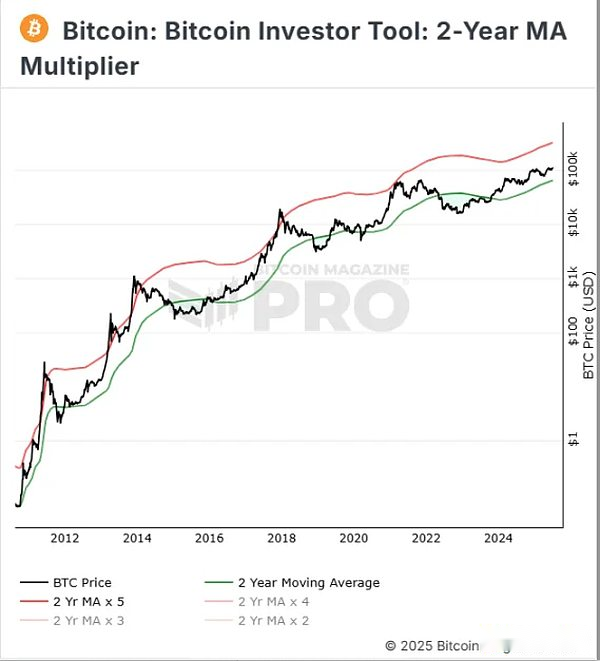 In its adoption phase, it is a form of currency that has defects in the short term.If you receive some bitcoin and want to use it to pay rent at the end of the month, neither you nor your landlord will be able to afford the situation where it could fall 20% in a month.The landlord’s spending depends on the network effects of existing fiat currencies; she needs to know the value of the rent received from the tenant.And as a tenant, you need to make sure you can pay rent in currency that will not depreciate quickly at the end of the month.
In its adoption phase, it is a form of currency that has defects in the short term.If you receive some bitcoin and want to use it to pay rent at the end of the month, neither you nor your landlord will be able to afford the situation where it could fall 20% in a month.The landlord’s spending depends on the network effects of existing fiat currencies; she needs to know the value of the rent received from the tenant.And as a tenant, you need to make sure you can pay rent in currency that will not depreciate quickly at the end of the month.
Therefore, Bitcoin is mainly regarded as an investment in this era.Believers are more likely to be willing to pay with it.People with specific payment problems (such as capital controls, payment platform bans, etc.) are also more likely to be willing to use them, although they are increasingly choosing stablecoins with similar liquidity to make payments.If you are just using stablecoins for a short period of time, their centralized nature does not matter.
Early Bitcoin supporters tried to convince Bitcoin holders to use Bitcoin more.I don’t think this is a sustainable approach.Bitcoin will not become popular as a charitable means.In order for it to continue to be popular on a large scale, it must address the payment gaps in the market for both spenders and recipients.And in the current adoption stage, this is not easy, especially when every transaction involves capital gains tax, and options such as stablecoins can meet short-term spending needs.
It has a sound, liquid, interchangeable and portable store of value, which provides holders with some advantages that other assets cannot provide during its adoption.They can bring Bitcoin anywhere in the world without relying on central counterparties and credit structures.It also allows holders to avoid significant fund wear and tear through cross-border payments, including recipients banned by the platform.They may not be able to pay with Bitcoin anytime, anywhere, but in most cases they can find ways to convert it into local currency and in some cases they can also pay with it directly.
Imagine you are going to a country at random.What currency can you bring to ensure you have enough purchasing power without relying on a global credit network?In other words, even if all your credit cards are deactivated, how do you make sure you can still trade, even if you will bear some financial wear?
The best answer at the moment is usually physical dollars.If you bring the dollar, although you may not be able to use it directly, it is easy to find someone willing to exchange it for local currency at a reasonable exchange rate and sufficient liquidity.
Other answers may be gold and silver and the euro.It is also not difficult to find a broker willing to accept gold, silver or euros and exchange it at fair local value in most countries.
The RMB, yen, pound and some other currencies may also be used as alternatives, but often face more funding wear and tear.I would put Bitcoin somewhere in the top 10, around 5 to 10, especially if you’re going to a city center.Most cities have many redemption options to seek help when needed.Given that Bitcoin is only 16 years old, this is already amazing.
More than 160 fiat currencies down are very bad currencies outside the country, and most of them are.
The US dollar is the most liquid currency in the world today.Smaller and less liquid assets are almost always denominated as larger and more liquid assets.People use larger and more liquid currencies as account units and use them as their main liabilities.
In the past, the US dollar was defined as a certain amount of gold.Eventually the US dollar network became larger and ubiquitous than gold, and the situation reversed: gold is now mainly denominated in US dollars.Bitcoin may surpass the dollar in this way over a long history, but it is far from reaching that level at this moment.It doesn’t matter what bitcoin is priced in the process; it is a bearer asset that can be priced in the largest and most liquid currency, and if one day it becomes the largest and most liquid currency, then other things will naturally be priced in it.
While people are free to make psychological pricing in any currency, most people will make pricing in bitcoin soon.Critics describe this as a flaw in Bitcoin; a new decentralized currency asset has no other path to go in its growth besides denominated in existing currencies.
Part 2: How businesses and Bitcoin stocks blend together
Back in 2014, Pierre Rochard wrote a prescient article titled “Speculative Attack.”
Speculative attacks in the forex market refer to borrowing weak currencies to buy more strong currencies or other high-quality assets.This is one of the reasons central banks raise interest rates, and some countries will turn to thorough capital controls to prevent entities from arbitrage on their mismanaged currencies.
Wikipedia provides an effective definition:
“In economics, speculative attacks are when previously inactive speculators suddenly sell unreliable assets and acquire certain valuable assets (currency, gold) accordingly.”
Due to the appreciation nature of Bitcoin, various entities will eventually borrow money to buy more Bitcoin.At that time, Bitcoin was slightly above $600 and its market capitalization was slightly above $8 billion.
At first, borrowing funds to buy Bitcoin was only a minority phenomenon.But now the Bitcoin network is highly liquid, with a market capitalization of over $2 trillion, and billions of dollars in corporate bonds from mainstream capital markets are dedicated to buying Bitcoin.
Today, 11 years later, this phenomenon has become commonplace. Is this good or bad for the Bitcoin network?
According to my observations, there are two main critics who believe this is not good for the Bitcoin network.
The first type of critics are themselves Bitcoin users.Many of them belong to the crypto-punk camp or sovereign-minded camp.From their perspective, handing over Bitcoin to the custodian seems dangerous, or at least violates the philosophy of decentralized networks.Some of them call corporate Bitcoin treasury supporters “suit Bitcoin enthusiasts”, which I think is a good term.This Bitcoin camp hopes that people will have their own private keys.Some of them further stated that recollateralization by major custodians could suppress prices or otherwise damage the value of Bitcoin as a free currency.While I like the values of this camp, some of them seem to have utopian dreams that want everyone to be as interested as they are in total control of their currency.
The second category of critics is usually the ones who have held negative views on Bitcoin in the past.They have questioned Bitcoin for years.As Bitcoin became the best performing asset and has been hitting new highs over the years and in multiple cycles, some of them changed their view and turned to think that “the price of Bitcoin may be rising, but its value has been captured.” I take this camp less seriously than the first camp.This is similar to the permanent bear theorists in the stock market, when their bearish arguments fail to come true in a decade, they will turn to say “the market is just rising because the Fed prints too much money.” My response is, “Well, yes, that’s why you shouldn’t be bearish.”
What I want to say to these two camps is: Some big capitals choose to hold Bitcoin, which does not mean that “liberal” Bitcoin has suffered any damage.It can be self-hosted and transferred as usual.And, as more types of entities hold it, the network becomes larger and less volatile, which also helps to improve its usefulness as a peer-to-peer payment currency.It may also provide political cover to help policy makers mainstream it.If Bitcoin reaches this scale, the emergence of Bitcoin stocks and the phenomenon of large capital purchasing Bitcoin will inevitably occur.
One skill for permanent bear marketers is to adjust the narrative at any time as needed so that they are right no matter what happens.Bitcoin is defined by them as having no reasonable path to success.What if Bitcoin stays at the niche level?Then its price increase and circulation capacity will be damaged, look, it failed!What if it is adopted by large entities and governments and continues to grow at a large scale?Then its value has been captured and lost.
But if it is to become huge, widely accepted and somehow change the world, how could this path not go through businesses and governments?
Bitcoin’s price push has gone through several major stages.
In the first stage, people use their computers to mine Bitcoin, or send money to Mt Gox to buy Bitcoin, and other early adopter behaviors of costs.This is the early user stage.
In the second phase, especially after Mt Gox went bankrupt, it became easier to buy and use Bitcoin.Domestic exchanges in many countries make it easier than ever to buy Bitcoin.The first batch of hardware wallets were released in 2014, making self-hosting safer.This is the retail buyer stage, and the slippage at the time of purchase is still there, but is decreasing.
In the third stage, Bitcoin became widespread, liquid enough, and had a long enough history to attract more institutions.Some entities have established institutional-level custody services for them, listed companies have begun to buy bitcoin, and various ETFs and other financial products have emerged, allowing various funds and custodial capital to gain exposure.Some countries, such as the Kingdom of Bhutan, El Salvador and the UAE, mine or buy and hold Bitcoin at the level of sovereign states.Other countries such as the United States choose to hold their confiscated Bitcoins rather than sell them directly.
Fortunately, although businesses are the main buyers at the moment, retail investors are still free to buy Bitcoin with zero wear.
I heard someone say, “I thought Bitcoin is for the people, and it pays cash on a peer-to-peer basis, but now it is held by large enterprises.” Bitcoin is indeed for the people, and anyone who can access the Internet can buy, hold or transfer it.
That’s why I agree with both crypto-punk and the Bitcoin enthusiasts in suits.I want Bitcoin to work as a free currency, which is a big reason why I became a general partner at Ego Death Capital.We provide funding for startups to build solutions for the Bitcoin network and its users.This is why I support the Human Rights Foundation and other nonprofits that fund developers and education providers, focusing on providing financial tools for people in an inflationary environment.However, once businesses, investment funds and even sovereign entities understand Bitcoin, it is reasonable for them to buy Bitcoin, and Bitcoin has now entered their horizon.
It is important to remember that most people are not active investors.They don’t buy stocks and don’t delve into the difference between Bitcoin and other cryptocurrencies.If they speculate as traders on an asset, they are likely to buy at the top and be washed out at the bottom.Their investments are usually distributed passively, not chosen by themselves.In the past, pension funds were usually allocated.Today, investments are usually made by financial advisors.
In my opinion, it is unreasonable to expect billions of people to buy Bitcoin on their own initiative.However, it is reasonable to work hard to lower the barriers to entry through technical solutions and educational resources so that anyone can choose to access Bitcoin.
The best statement I’ve seen is: “Bitcoin is for anyone, not for everyone.” In practice, this means that everyone should be guided to understand Bitcoin, but only a few people will choose to accept it.
Summary of the key points
The development of Bitcoin monetization is roughly as follows:
Bitcoin was originally a collection of enthusiasts and people with dreams of change, a new technology that could provide people with some value.
Bitcoin began to become a medium of situational exchange, even used by pragmatists who did not pay attention to it.For example, when funds need to be sent to a country with capital controls, Bitcoin can be transferred when other payment channels fail.Bitcoin can be a great solution when it needs to be accepted for payments or donations, but is banned by major online payment platforms such as WikiLeaks.
Various purchase costs such as high volatility, numerous competitors and capital gains taxes have hindered the continued growth of Bitcoin as a common medium of exchange.If you use Bitcoin to pay merchants who do not hold Bitcoin and they automatically exchange it for fiat currency, the benefits of Bitcoin cannot be fully realized.
Bitcoin is more widely regarded as an ideal portable appreciation capital.Unlike other cryptocurrencies, it achieves decentralization, security, simplicity, scarcity and scale, making it a worthy asset to hold for a long time.While it is not always easy to buy coffee with it, it has begun to enter the top ten bearer assets that can be carried and exchanged for local value when traveling internationally, surpassing the vast majority of fiat currencies.
The Bitcoin network is liquid, scale and durable enough to attract active attention from businesses and governments.A large amount of custodial capital is interested in this asset, and businesses and funds provide them with opportunities to indirectly access to Bitcoin.Meanwhile Bitcoin continues to exist as an open and permissionless network, which means individuals continue to use and build it too.
If the Bitcoin network continues to scale, they may implement:
As the Bitcoin network becomes larger, more liquid and less volatile, it will also become more attractive to large sovereign entities.Initially, Bitcoin was just an asset invested by small sovereign funds and could eventually become a large-scale foreign exchange reserve or international settlement tool.Countries have been trying to build alternative payment methods for closed source code, but the adoption rate is low and there is a lack of consensus, and this open source settlement network with limited supply of independent units is gradually penetrating around the world.
Overall, I still think Bitcoin is in good shape in terms of technology and economy, and its adoption path is expanding as expected.

